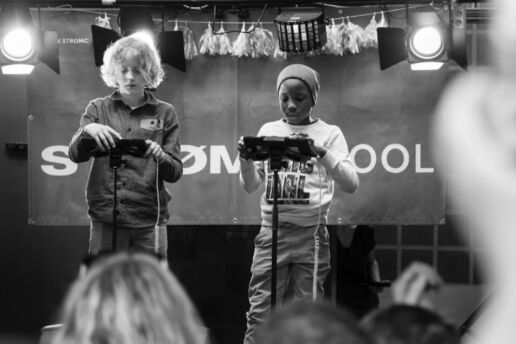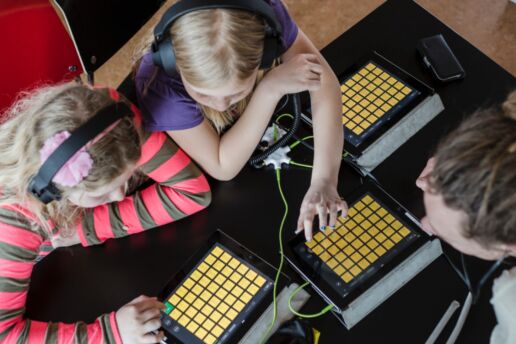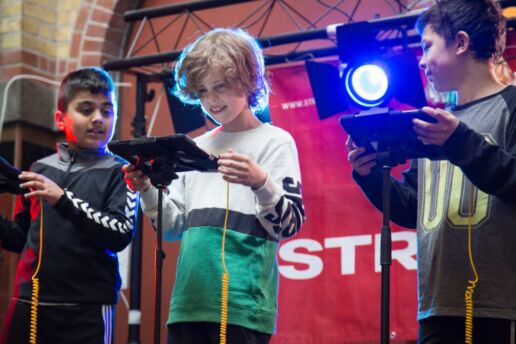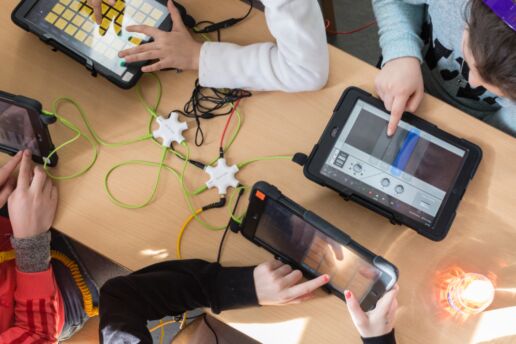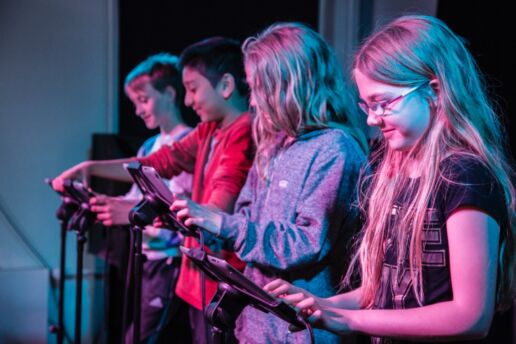In my opinion: If you hear you are going to have this course at your school: be excited. It is fun, relaxing, and you can do it with your classmates and best friends.
Mie · Student of 4B, Bronshoj School, Denmark · Quote from documentary video.
Info for schools
Offer students a week of intense music creation
Here, you can get an idea of how to provide our inclusive teaching programme for your school class or summer camp. You will find separate sections below about the course's structure, lessons, materials, etc. We recommend watching the documentary video if you want a quick impression of the teaching process. Don't hesitate to contact us if you have questions or need more information.
Structure
The teaching structure follows a carefully planned progression for five days. First, the students explore musical form on their iPads; then, they create rhythms and move on to melody, improvisation, and harmony creation. Later they compose their music pieces and perform on stage in groups of two to four students. In the context of Bloom's taxonomy, students invisibly take quick steps back and forth on the ladder of knowledge, skills, reflection, and exploration, at last being able to create music themselves.
Activity overview:
Monday 8:00-11:30: Introduction · Musical form · Make A Beat · Variations
Tuesday 8:00-11:30: Recap · Make A Melody · Harmony · Playing In Pairs
Wednesday 8:00-11:30: Recap · Recording and Sampling · Forming Groups
Thursday 8:00-11:30: Recap · Improvisation · Music Making in groups
Friday 13:00-16:00: Rehearsal and Tech Run. Concert for parents: 16:00-17:00
Each lesson contains short practical assignments with students wearing headphones, which makes the classroom climate calm and concentrated. Silence is broken during group reflections or when students play their creations or show their skills to each other through a portable speaker: The inevitable occurring applause will encourage everyone.
The final product – students presenting and performing their music in The Electronic School Concert on iPads at a local venue – is diverse, touching, and unpredictable. Students will be nervous, but they will do it. Parents will enjoy and document the concert. Feedback from teachers tells of transformed classes with a higher level of social belonging.
Lessons
Each lesson lasts approximately forty-five minutes and follows the same pedagogical three-segment progression: A brief introduction, then some practical exploration, imitation or improvisation and at last, a group reflection. We use Transparent Assignment Design: Each task and its accomplishment and success criteria are clearly described.
For example, the course’s first lesson, ‘What is a song?’, consists of three segments of ten, twenty, and fifteen minutes each. The objective is to give students a practical understanding of musical form.
In the first segment of the lesson, the teacher asks the class about musical form terms to create a shared language for the rest of the teaching. The students will, for example, answer that there is something called a verse, a chorus, an intro, etc.
In the second segment of the lesson, the students put on their headphones and open a song on their iPad, visually presented as one long waveform. Their task is to identify and mark musical changes by inserting ten ‘bookmarks’. That takes them around 15 minutes, and they usually like to compare their findings with classmates.
The third segment is a group reflection in the class. The song structure is set, and students play their bookmarks by connecting their iPad to a speaker. Finally, the students get a few minutes to experiment with the musical form. Since they have used a DJ app, they can skip around in the song, repeat elements, shorten form parts, scratch, etc.
The last little exercise certainly motivates the students and nudges their self-understanding: ‘I can change the music, I can create new music.’ The lesson moves students from a traditional analytical and consuming position to a deconstructive and co-creative one. They become aware of their creative potential and are ready to transfer their knowledge and experience to the following similar lessons: Rhythm, Melody, and Harmony.
Preparations
Executing The Electronic School Concert programme for the first time is a big decision for every school and takes time in preparation, planning, and training. Therefore it makes sense to offer the course to every class of the same grade or consider running it for several school years with the same team of instructors.
The programme is designed for ten to eleven-year-old students, equal to the 4th grade of Danish schools. However, 3rd and 5th-grade classes have also completed the course with good results. Lessons and materials can be adapted to the level of the class.
Preparation includes two meetings:
- A one-hour planning meeting with school executives and teachers at least eight weeks before kick-off. Agenda: Booking of teachers and instructors, dedicating an entire week, finding a concert venue, technical requirements, and information for parents.
- A four-hour workshop for educators 1-2 weeks before kick-off. The workshop will prepare teachers and instructors for the pedagogical foundation of the programme and guide them to handle all the individual lessons and apps.
Meetings can be online if necessary.
Programme and technology limitations:
The course might not give optimal results if altered considerably. To ensure the quality of learning, condensing or spreading the programme across more weeks is not recommended. Some schools have tried to execute a ‘light version’, but it appears that five days, approximately twenty clock hours, is the minimum. Also, not every technology supports the programme; At the time of writing this, the course cannot run on desktop computers, laptops, smartphones, traditional music instruments, or android tablets. We hope the future will bring us more flexibility regarding the choice of platform.
Team
The Electronic School Concert programme challenges both teachers and students but does not require long specialist training. Setting a great team is still important. Music teachers are the obvious choice; however, it is even more critical that instructors know students well or can connect with the class and get their full attention quickly. Adults on the project can advantageously identify themselves as facilitators rather than as teachers.
The core task of the team is to creatively support and motivate each student through five days that are probably quite unlike anything else they have experienced in their classroom. So a passionate, outgoing language teacher with excellent pedagogic skills and a flair for music and technology can be just as successful as a traditionally trained music teacher.
The programme requires two adults in the classroom at any given time. Students will need practical and individual directions with tasks and technologies during the first two days. On days three and four, more emotional and creative support is needed; the teachers will circulate the classroom, and some groups and individuals will undoubtedly question their abilities even if they are doing great. When running the course for the first time, we recommend having an experienced instructor from The Electronic School Concert participate most days.
Locations
All lessons of The Electronic School Concert take place in the classroom, apart from the final day's concert, which requires a stage and an audience of parents, grandparents, siblings, teachers, and friends.
The Electronic School Concert works best in everyday teaching spaces. In the classroom, everybody knows their seat, and students are probably seated to create the best working climate. We recommend not to use the music room. The presence of traditional instruments diverts focus from the tablet, which in this course becomes the actual ‘musical instrument.’ The music room itself might even suggest specific roles or promote individual musical skills, which contradicts the intention behind The Electronic Concert: To give every student the same platform, no matter their musical background. Read more about the ideas behind our programme under Mission and Vision.
The final concert on the last day requires a small stage and a PA system. We learned that local venues or community spaces generally love the project and kindly offer their facilities for a couple of hours to support it. Usually, venues also let the students rehearse on site. Local music festivals have even included the concert in their programme a few times. Alternatively, a room with a stage in the school can be utilised. However, it takes away some of the excitement for the students: They find it remarkable to enter a ‘real’ stage. Another benefit of using a venue is that they usually have a cafe or bar where parents can get a cup of coffee before or after the show.
Materials
The Electronic School Concert naturally requires iPads and other hardware, specific software apps, and teaching materials. It raises the question: How can a school source the equipment, especially the tablets?
Many schools have rather large quantities of iPads, but still, need other equipment. School iPads might even vary in type and condition. We know from several fulfilled courses that sourcing and preparing iPads, other equipment, and software takes some time.
Therefore, The Electronic School Concert will soon be able to provide a complete set of hardware and software from our programme supporters. Meanwhile, we borrow some of the hardware from schools and other institutions possessing the necessary equipment.
By offering a complete set of hardware and software, we hope that equipment limitations will not prevent schools from providing the course to their classes.
Listed below are the actual requirements:
Teaching/Learning Materials (TLM):
Each lesson requires different materials, some printed, some in electronic form. A complete set of TLM Teaching/Learning Materials is included with the programme.
Software requirements:
The inevitable question educators raise: Which app is used for The Electronic School Concert? However, there is no quick fix. For the moment, no single app covers all teaching needs. We use a handful of apps, most of them are free, and each one fits specific lessons or purposes. Some of the apps currently in use are:
- Garage Band
- DM1 Drum Machine
- Figure
- Traktor DJ
- iMachine sampler
However, the palette of available apps is constantly changing, and the best suitable ones are incorporated into the course.
Hardware requirements:
- 1 x iPad per student
- 1 x set of headphones per student, Over-Ear type
- 4 x iPad stands for the concert
- 10 x 6 way 3.5mm headphone stereo audio splitters
- 1 x battery-driven portable speaker of good quality
- 5 x 5m cables: 3.5mm stereo jack to 6.3 mm stereo jack or XLR
- Projector, a large monitor or smartboard in the classroom
- Connectors and cables for projection from iPad to projector or smartboard
Costs
The total cost for the five-day programme is typically between EUR 1.400 - 2.600, depending on the number of external teaching hours and courses. Please get in touch with us for further information.
Distribution of expenses:
- Teaching materials
- One-hour planning meeting
- Four-hour workshop
- Hourly wages for instructors
For the course’s first run, an external instructor is necessary for fourteen hours as a minimum. Some schools exclusively use external instructors, but we recommend a combination of teachers and instructors. After the first implementation, schools can rely more on internal resources, bringing down the costs of subsequent courses.
In-service training / CPD:
Several schools have set aside education funds to cover the costs of the course, as it can be regarded as in-service training for music and classroom teachers.
Please write or call us if you have any questions regarding the costs and implementation of the Electronic School Concert.





 Dansk
Dansk